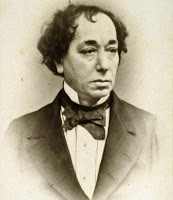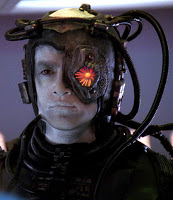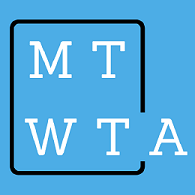
“Change is inevitable.”
–Benjamin Disraeli (1804-1881), British politician, statesman, and novelist.

“Resistance is futile.”
–The Borg (first contact stardate 42761, with U.S.S. Enterprise), cybernetic life-form intent on assimilating the technology of all species it encounters.
While these statements may be equally true, one is at least a little less intimidating than the other. In implementing my innovation plan, I hope to make use of the former without having to resort to the mindset of the latter. Which is probably fortunate for my colleagues (and really a moot point, since I have no access to Borg technology).
In several previous posts, I have outlined different strategies and methods I intend to employ in order to convince my colleagues to adopt my plan:
“I Can Get Satisfaction” (Start With Why)
First, I have tried to take Sinek’s advice to heart: “People don’t buy what you do; they buy why you do it” (2009). To that end, I have drilled down to the driving purpose, or the “why,” behind my innovation plan; namely, that understanding and utilizing the creative process will help learners develop a growth mindset, which is vital to all learning. This “why” statement is at the core of everything I am hoping to accomplish. With it, all of the elements of my plan have purpose and, hopefully, will resonate with my colleagues as I try to persuade them to go along with my plan. Without it, all of my work and ideas boil down to teachers a) spending some time learning to use digital audio software, and then B) being asked to add one more task of unclear value to their already overflowing plates.
“Exerting My Influence” (Influencer: The New Science of Leading Change)
Next comes the subtle art of actually trying to get that resonance and persuasion to happen. Applying the strategies outlined in 2013’s Influencer: The New Science of Leading Change, I have first defined some vital behaviors that teachers participating in my plan will need to undertake if the desired results are to be realized–namely, that these teachers in multiple academic disciplines will adapt and adopt the ideas and practices that they themselves experienced as learners in the Technology-Assisted Music course. In order to convince teachers that this path is worth following, I have then outlined strategies for taking advantage of the six sources of influence that Influencer describes, leveraging both motivation and abilities in personal, social, and structural domains–for example, using teachers as resources for one another as they implement the lessons of the course in their own classrooms.
“Eating Elephants and Innovating Education” (The 4 Disciplines of Execution: Achieving Your Wildly Important Goals)
Once my colleagues are buying why I do what I do, and have been convinced that they can and should do the same, a clear, consistent, and well-defined set of actions and goals needs to be put in place. This is where the lessons of 2012’s The 4 Disciplines of Execution come into play, setting out a more tactics-driven approach that complements the influencer strategies described previously. Goals are defined, actions and behaviors that will lead to the accomplishment of those goals are laid out, and, perhaps most importantly, a clear system of team accountability for those actions is established. One key element of the implementation of these tactics, which I hope will contribute to teacher buy-in to the overall plan, is the degree to which the teachers themselves are responsible for determining specific goals, behaviors, and measures of accountability. While the overall goal is to introduce the idea and benefits of the creative process into all disciplines, the teachers who are responsible for bringing this process to their individual learning environments are the best people to determine what the lag and lead measures toward that goal look like, and how best to implement them. Giving them this freedom (and responsibility) make them far more likely to achieve the desired results.
“Talking the Talk” (Crucial Conversations: Tools for Talking When the Stakes are High)
Finally, what to do when resistance (as inevitable as change itself) does make an appearance? Adopting the lessons of Grenny et al. from 2012’s Crucial Conversations, I break down my strategies for dealing with what I anticipate will be the greatest form of resistance to my plan–“innovation fatigue” on the part of teachers. These strategies (indeed, all of my strategies) involve revisiting my “why,” in order to be clear about what I am actually trying to accomplish. They also involve seeking to understand the emotions behind the actions of others, finding common ground among those emotions, and creating a plan of action once the conversation is concluded.
The EDLD 5304 course has given me many ways to think about the realities and pitfalls of implementing change among my colleagues and within my organization. From Sinek’s philosophical advice to the nuts-and-bolts suggestions of 4DX and all points in between, I now have a well-stocked toolbox of both concrete techniques and illuminating concepts with which to tackle this admittedly large and wide-ranging task. For someone who never really imagined undertaking something this ambitious, I suddenly feel remarkably well-equipped.
Perhaps resistance IS futile, after all.
REFERENCES
Borg. (n.d.) Retrieved February 24, 2019, from http://www.startrek.com/database_article/borg
Covey, S., Huling, J., & McChesney, C. (2012). The 4 disciplines of execution. London: Simon & Schuster UK Ltd.
Dweck, C. S. (2016). Mindset: The new psychology of success. New York, NY: Ballantine Books.
Grenny, J., Maxfield, D., McMillan, R., Patterson, K., & Switzler, A. (2013). Influencer: The new science of leading change (2nd ed.). New York, NY: McGraw Hill.
Grenny, J., McMillan, R., Patterson, K., & Swizler, A. (2012). Crucial conversations: tools for talking when stakes are high. (2nd ed.). New York, NY: McGraw Hill.
Sinek, S. (2009). Start with why [Video file]. Retrieved from https://youtu.be/sioZd3AxmnE


